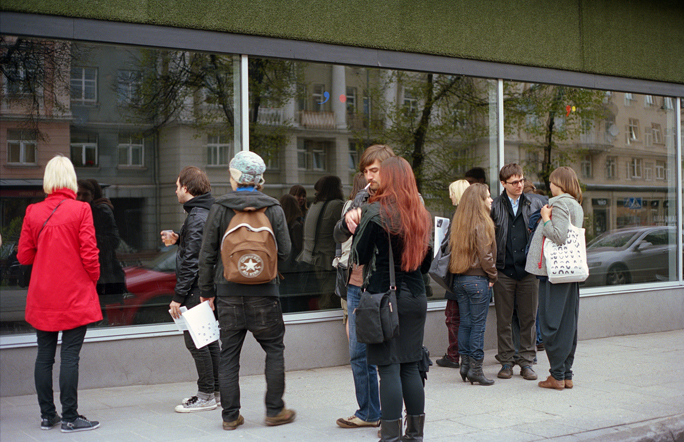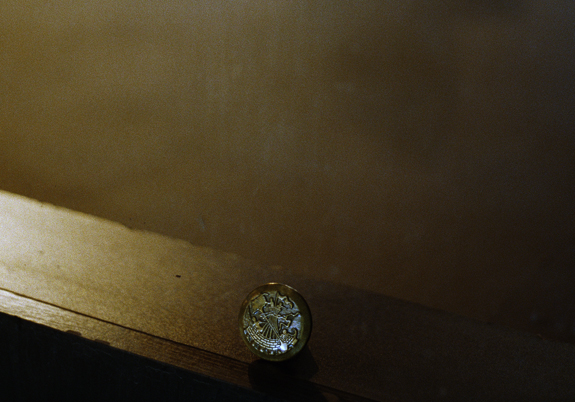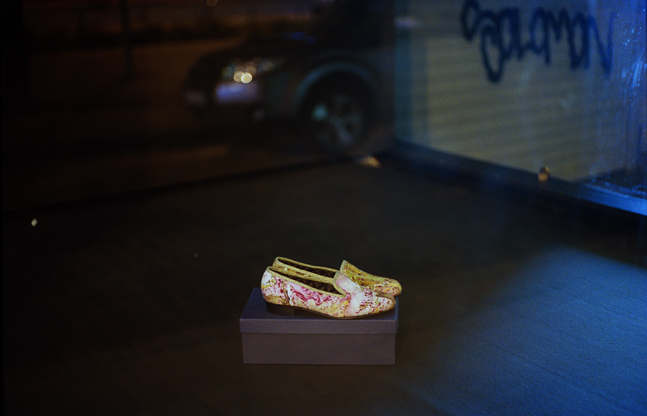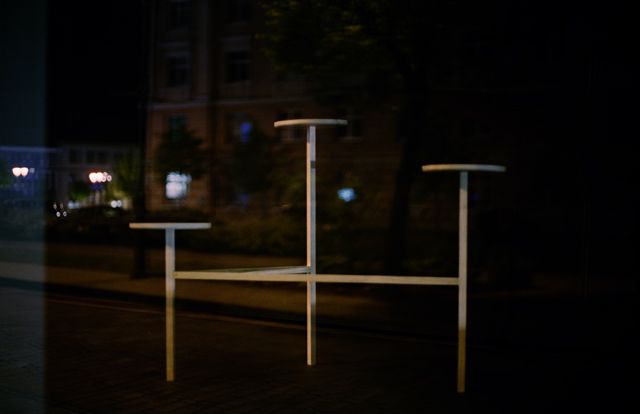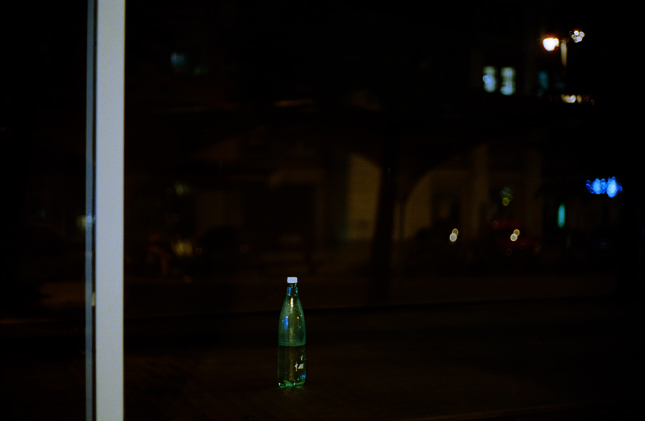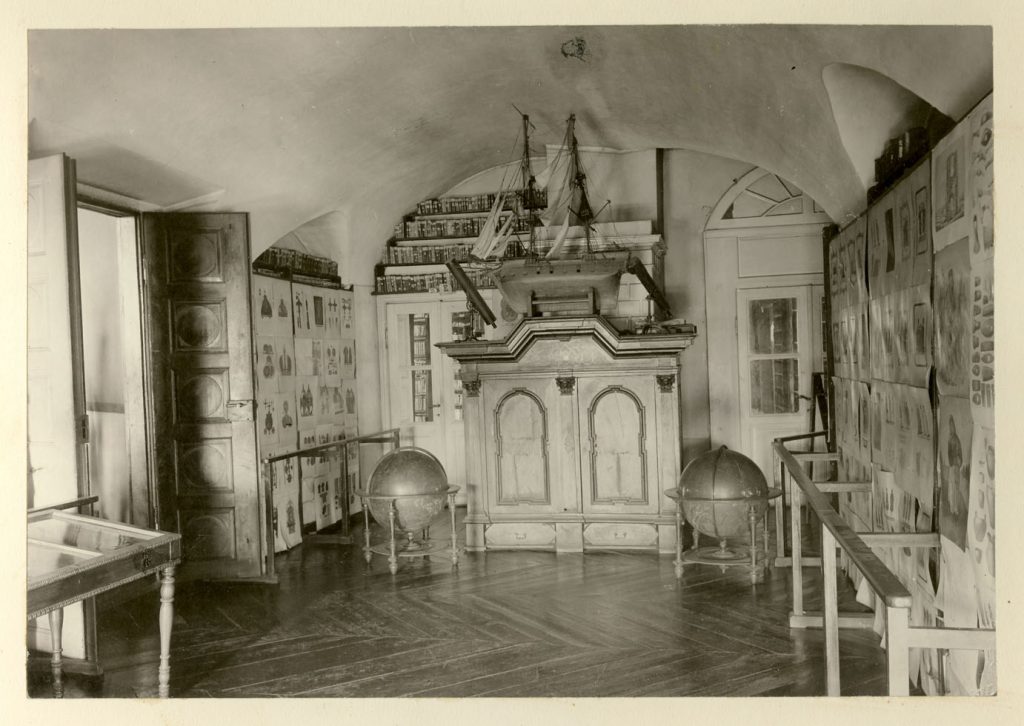
Participants:
Anonym, Goda Budvytytė, Liudvikas Buklys, Gintaras Didžiapetris, Antanas Dombrovskis, Stanisław Filibert Fleury, Antanas Gerlikas, Martijn In‘t Veld, Juozas Laivys, Raimundas Malašauskas, Nicolas Matranga, Elena Narbutaitė, Peter I, Post Brothers, Jennifer Teets, 2Easy Fashion, Ola Vasiljeva
&
‘Yearbook’ collective (Goda Budvytytė, Kevin Killian, Falke Pisano, Adam Putnam, Aaron Schuster, Alex Cecchetti, Marco Belfiore, Juozas Laivys together with Darius Mikšys, Benoît Maire, Gintaras Didžiapetris, Jessie Ash, Patricia Esquivias, Yi-Ping Hou & Joe Miceli)
Physical spaces:
Heden Hier gallery, The Hague; Contemporary Art Centre and its premises, Vilnius; Vilnius Antiquity museum; Lithuanian Archives Department;
Lithuanian National Museum; Place du Petit Sablon, Brussels;
Curator: Valentinas Klimašauskas
Designer: Goda Budvytytė
The Title as a Premise of an Exhibition’s Existence
‘If you do know that here is one hand, we’ll grant you all the rest’ – those are the opening words of Ludwig Wittgenstein’s On Certainty; a book that only existed in the form of personal notes in the author’s notebook while he was alive. Wittgenstein borrows the ‘hand’ from George Edward Moore’s (1873-1958) text A Defence of Common Sense (1925), in which the latter argues that if he has hands, ‘an external world’ is bound to exist.
In his defence of common sense, Moore had employed a series of performative actions. First of all, he lifted his right hand and said: ‘Here is one hand’. Then he lifted his left hand and said: ‘And here is another’. With the third utterance he confirmed what did not appear evident to the sceptics: ‘Thus, at least two hands exist in the external world, and therefore I know that an external world exists’. Yet Ludwig Wittgenstein prompted one to doubt this logic. Referring to the fact that nobody had ever seen their brain, he turned that statement into a question: ‘do I know that I have a brain?’.
This discussion about the confirmation, refutation and substantiation of seemingly evident things inspires one to meditate on the possibilities of putting together an exhibition. If the notion of ‘common sense’ can be grounded in such an effortless manner, why don’t we deconstruct, reassemble and multiply the connections between the hand and the brain operating it so as to create new hands, brains and connections between them? In this way, the present exhibition, which has its beginning in (through, about, from) CAC’s showcase, seeks to create new and reveal the already existing relationships between bodies, organs, brains, internal and external networks.
Let’s return to Ludwig Wittgenstein, or, rather, to his brother Paul Wittgenstein at this point. Paul was a one-armed pianist who had lost his right arm during World War I. He became famous precisely for being able to perform works that had previously been considered impossible to play for a performer with just five fingers. Let us imagine Paul Wittgenstein attempting to re-enact Moore’s performative ‘defence of common sense’. First of all, he would lift his right arm and say: ‘Here is my right hand (it is absent only for the moment, or it is elsewhere at the moment)’. Then he would lift his left arm and state: ‘Here is my left hand’. With his third statement he would confirm what would not appear evident to the sceptics: ‘Thus, at least two hands exist in the external world, and therefore I know that an external world exists’.
Paul Wittgenstein’s right arm, the one that’s been lost, exists differently than the remaining one. This missing arm exists as a temporary lack; it exists by not existing. Although in his concerts Paul played the works written specifically for him by Sergey Prokofyev, Richard Strauss or Maurice Ravel with his left hand, the right, non-existing and non-playing one had a solid influence on how the listeners perceived the sound of music.
But let us go back to the exhibition. Following the line of Moore’s argument, an exhibition may exist as long as we provide the premises of its existence (for instance, by proving the existence of its title). In the same way, the existence of an exhibition is possible if its title acts as a ‘missing hand’ – through temporary absence (that is, the title had indeed existed or will exist, yet for certain reasons we may not know it at the present moment). It means that a title is not necessary in order to prove an exhibition’s existence. An exhibition can equally exist through what directly defines it and its parts, and through what is missing in it (like space, works to be displayed, authors, etc.), what is lacking at this or other point in time, yet, precisely by its active absence and lack, makes possible the exhibition’s existence and resonance.
The Exhibition’s Spaces: Showcase, Model, Diorama, Map, Scale, Organ Without A Body, Collection Of Potentials, Isolated Brain, Brain Wrapped In Cotton-Wool, White Cube, Product Paradise, In Vitro, Heterotopia, Network, Other
The showcase (Vokiečių st. 2, formerly Grasas pub) can as well be a model of a gallery, functioning as its diorama.
A diorama is a three-dimensional life-size or scale model of a certain environment. Dioramas are usually found in museums; one of the best-known dioramas in Lithuania is the reconstruction of the site where the accident of Darius and Girėnas’ plane Lituanica took place, on display in Vytautas Magnus War Museum in Kaunas. Like the map, especially if scaled 1:1, any model has a problem of scale . The scale of an object is what defines its quantitative relationship with reality and its limits in the external world, and divides the object into its inside and outside.
The part of this exhibition that is displayed in the showcase is a diorama that is at the same time a part of the show and its model. A similar relationship can be discovered between a body and a hand that belongs to it yet is missing. The model of a hand without a body is a feasible one too – remember Thing T. Thing, the hand character from The Addams Family. May it be that Thing T. Thing embodies the inverse version of Deleuze and Guattari’s body without organs concept – an organ without a body? A ‘body without organs’ is described as a collection of potentials, ‘permeated by unformed, unstable matters, by flows in all directions, by free intensities or nomadic singularities, by mad or transitory particles’ . ‘An organ without a body’ functions as an exhibit of the mentioned collection of potentials, a materialization of a particular single potentiality. Examples of organs without bodies include the isolated brain and brain wrapped in cotton-wool, like that in Stanislaw Lem’s Solaris, where the eponymous planet is portrayed as the Earth’s radical contrast.
In comparison to the ideological white cube gallery space, the showcase is more open both physically and ideologically because of its glass-like lucidity; it is a space of references. Meanwhile, the pure white cube space is an ideal environment that declares its independence from the external world and time.
The showcases of stores and cinemas act as a promise of what’s to be found inside. Besides, showcases (just like specialised trade fairs) can contain prototypes, concept models, beta versions, mannequins, pilot trailers, ad posters, collages, assemblages, dioramas and works done in other techniques that are destined to remain showcase-oriented, non-serialised concept projects.
Thus, the showcase functions as a transparent reference to at least two worlds – the symbolic (for instance, that of the white cube or the product paradise, an ideal space for products to exist) and external (physical, consumption) ones, therefore it essentially is a heterotopia. According to Michel Foucault, heterotopia is a concept in human geography that describes places and spaces that function in non-hegemonic conditions. These are spaces of otherness, which are neither here nor there, that are simultaneously physical and mental, such as the space of a phone call or the moment when you see yourself in the mirror.
The notion of the showcase as a heterotopical entity can be fostered by its resemblance to in vitro (Latin for within the glass) procedures. The latter are laboratory tests that are performed in a controlled environment (such as the test tube), rather than in a living organism. Thus, the showcase can be viewed and employed as a test space for research and experiments.
If we refer to one of the mentioned spaces functioning in the showcase located in Vokiečių st. as the exhibition’s space, we will have to make a conclusion that a showcase is and is not a showcase at the same time, just as it simultaneously is and is not a showcase, model, diorama, map, scale, organ without a body, collection of potentials, isolated brain, brain wrapped in cotton-wool, white cube, consumer paradise, in vitro, heterotopia, network and other spaces.
The Times (of the Exhibition)
In a sense, If you do know that here is one hand is a re-enactment of an exhibition that probably never happened, but can open at any time. This project explores the possibilities and limits of an exhibition’s emergence and “functioning” – most of the display’s components previously existed (functioned), exist (function) and/or will exist (function) by themselves, not being a part of this exhibition. Thus we can also think of this project as a network of potentialities, functioning only in the audience’s memory, with its particular works, participants, members, nodes, actants, organs and other elements (depending on the preferred discourse) scattered across different points of space-time and memory.
This exhibition is not a usual one in the sense of the space it takes place in. If the habitual exhibition format calls for an installation of works (or processes) in a single physical space, the space occupied by the present exhibition is primarily the viewer’s memory. The imaginary space of the exhibition, initially located in the former premises of Grasas pub (Vokiečių st. 2), was being filled and emptied (with or of suggestions, critique, works and ideas) during the conversations with the participating artists. As a matter of fact, during such conversations (let’s keep in mind that the latter represent yet another model of networked performativity), the space of the exhibition was being filled up precisely by being emptied, until it became completely delocalised and got distributed across an expanded field of space and time, encompassing the viewers’ memory, the map of the exhibition, the Contemporary Art Centre, Lithuanian Special Archives, the National Museum of Lithuania, Vilnius University Library, currency flows, the Šiaurės Atėnai (North Athens) culture newspaper, Heden Hier in the Hague, Parc de Bruxelles in Brussels, etc.
Let’s go back to this exhibition’s proper space – the viewer’s memory and time. As already mentioned, the major part of the works displayed already existed (functioned) before, thus it is possible to imagine a viewer who already saw the show, since its exhibits already entered his or her memory. Therefore, it is plausible that this exhibition is a re-enactment of an exhibition that already took place in one’s memory at some point. The probability that an exhibition already existed in the past, and maybe continues to do so up to this moment, contradicts the customary mechanism of an exhibition opening (vernissage) – for one cannot announce the beginning of something that has already had a beginning. When an exhibition that is open only in one’s memory gets transferred to the physical outside and assumes a tangible form, it essentially starts to act as a realisation of memory and, at the same time, exhibition closure (finissage). Thus the opening of this exhibition is rather a rehearsal of recollections, during which the accuracy of memory is tested and memory itself is activated by new connections and contexts. During and after the time of its activity, the exhibition will again relocate to the audience’s memory, and will thus become a heterotopia – a memory of an exhibition, situated in a timeless time and a placeless place.
This exhibition functions as a network of heterotopias (from Greek hetero, ‘different’, and ‘topos’, place) and heteroorgans (a special unit of an organism’s framework, an agency or an instrument via which the heterotopia operates). Michel Foucault talks about the museum as a heterotopia of time (or heterochronia), a place that contains works belonging to different styles and epochs . The concept of heterotopia can be employed for describing not only spaces and their constitutive parts (larger heterotopias may enclose smaller ones), but also movement through time and space or relocation from one point to another in physical or immaterial form. Heterotopia is a state of flotation, which creates a possibility of being in at least two places at the same time. Foucault said the ship to be an example of ideal heterotopia:
In the 20th century, the heterotopia of the ship had been replaced by that of the plane (this had been marked, in particular, by the Titanic catastrophe), while the latter was, in its turn, replaced by the heterotopia of the automobile; in the present age of network culture, however, the dominant heterotopia is the delocalising network(s). Attempting to define the era we live in, Kazys Varnelis Jr. states that ‘our age – although other ages had their own networks – is the first modern age, in which the network, not the centralised hierarchy, is the principal paradigm of organisation’.
Similarly, the viewer of the present exhibition becomes one only as soon as the exhibition emerges in his memory as a network of heterotopias and heteroorgans , rather than a binomial ‘work of art – viewer’ loop. If the ship is an ideal case of heterotopia, then one example of a heteroorgan is the eye. When you look into an eye, you see more than just an anatomical eye – an organ of vision (defined by colour, size, iris and crystalline lens) – looking back at you. The eye functions as an organ that sends information both ways at the same time – the features of an eye looking at you can indicate its owner’s state of mind (‘the eyes are the mirror of the soul’), thoughts, intentions, and so on.
The works included in this exhibition resemble heteroorgans – first, they function by themselves; second, they are characters of a narrative constructed in the extended field of culture; third, they perform certain specific functions in the context of this exhibition, meeting its viewers face-to-face.

